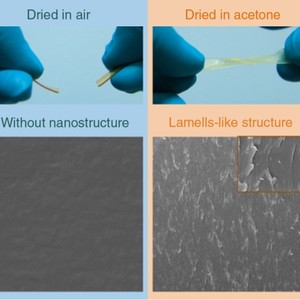Flexible Dry Hydrogel with Lamella-Like Structure Engineered via Dehydration in Poor Solvent
Citation
Feilong Zhang, Jiajia Zhou, Zhen Gu, Man Yang, Siheng Li, Yongyang Song, Jun-Bing Fan, Jingxin Meng, Peiyi Wu, Lei Jiang, and Shutao Wang*. Flexible Dry Hydrogel with Lamella-Like Structure Engineered Via Dehydration in Poor Solvent. CCS Chemistry 2019, 1, 533-543.
Abstract
Hydrogels are among the most promising biologic materials in recent technology with numerous desired applications, including serving as biosensors, drug delivery vehicles, and tissue-engineered products for cell matrices. However, they often dehydrate, and become stiff and brittle in air, causing loss of flexibility and functions. Several layered structures have been proven to increase the strength, toughness, and even flexibility of these materials, which might provide a new clue for the sustenance of the flexibility of drying gels. Herein, we report a novel solvent-dehydrated hydrogel engineering approach, aimed to change the inner structure and keep the flexibility of a dehydrated hydrogel in the air via solvent-induced dehydration, for example, acetone-dehydrated polyacrylic acid hydrogel. This flexible dry gel could be folded, twisted, and stretched without any damage due to the assumed lamella-like structures, contrary to dry gels without these microstructures or those with porous structures, which retain brittle consistency. The flexible dry gel also exhibited excellent self-healing capability with the assistance of solvents. Fascinatingly, this flexible gel film displayed strain-visualizing paper writing/erasing performance properties, with water acting as invisible ink. Thus, this fabricated flexible hydrogel film might function as confidential information storage material. Our current approach is versatile, hence applicable to other hydrogels, and provides insight into the engineering of other functional gels for extended future applications.


